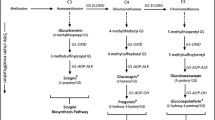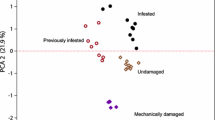Abstract
Chemicals previously identified as kairomones utilized by parasitoids have been found in significant quantities in food plants of host insects. Different plant species contain varying concentrations and ratios of these chemicals. Feeding studies with chemically labeled kairomones indicate that these cues are concentrated and released unaltered by the host insect. In this report, a theoretical framework consistent with these findings is considered.
Similar content being viewed by others
References
Arthur, A.P. 1962. Influence of host tree on abundance ofItoplectis conquisitor (Say) (Hymenoptera: Ichneumonidae), a polyphagous parasite of the European Pine Shoot Moth,Rhyacionia buoliana (Schiff.) (Lepidoptera: Olethreutidae).Can. Entomol. 94:337–347.
Brower, L.P. 1969. Ecological chemistry.Sci. Am. 220(2):22.
Brower, L.P. McEvoy, P.B. Williamson, K.L., andFlannery, M.A. 1972. Variation in cardiac glycoside content of monarch butterflies from natural populations in eastern North America.Sci. Am. 177:426–429.
Brown, W.L., Jr., Eisner, T., andWhittaker, R.H. 1970. Allomones and kairomones: Transspecific chemical messengers.BioScience 20:21, 22.
Budzikiewicz, H. Djerassi, C., andWilliams, D.H. 1967. Mass Spectrometry of Organic Compounds. Holden-Day, Inc., San Francisco. 214.
DeSouza, N.J. Ghisalberti, E.L. Rees, H.H., andGoodwin, T.W. 1969. Studies on insect moulting hormones: Biosynthesis of ponasterone A and ecdysterone from [2-14C]mevalonate inTaxus baccata.Biochem. J. 114:895, 896.
Eglinton, G., andHamilton, R.J. 1963. The distribution of alkanes, pp. 187–217,in T. Swain (ed.), Chemical Plant Taxonomy. Academic Press, New York.
Eisner, T. Johnesee, J.A. Carrel, J. Hendry, L.B., andMeinwald, J. 1974. Defensive use by an insect of a plant resin.Science 184:996–999.
Hendry, L.B. Anderson, M.E. Jugovich, J. Mumma, R.O. Robacker, D., andKosarych, Z. 1975a. Sex pheromone of the oak leaf roller: A complex chemical messenger system identified by mass fragmentography.Science 187:355–357.
Hendry, L.B.Greany, P.D., andfnGill, R.J. 197. Kairomone mediated host-finding behavior in the parasitic waspOrgilus lepidus.Entomol. Exp. Appl. 16:471–477.
Hendry, L.B., andHindenlang, D.M. 1975. Insect sex pheromones—Identification by mass fragmentography.Finnigan Spectra 5(1): 1–3.
Hendry, L.B. Wichmann, J.K. Hindenlang, D.M. Mumma, R.O., andAnderson, M.E. 1975b. Evidence for origin of insect sex pheromones: Presence in food plants.Science 188:59–63.
Herrebout, W.M., andVan Der Veer, J. 1969. Habitat selection inEucarcelia rutilla Vill. (Diptera: Tachinidae) III: Preliminary results of olfactometer experiments with females of known age.Z. Angew. Entomol. 64:55–61.
Jones, R.L. Lewis, W.J. Beroza, M. Bierl, B.A., andSparks, A.N. 1973. Host-seeking stimulants (kairomones) for the egg parasite,Trichogramma evanescens.Environ. Entomol. 2:593–596.
Lewis, W.J. Jones, R.L. Nordlund, P.A., andSparks, A.N. 1975. Kairomones and their use for management of entomophagous insects: I. Evaluation for increasing rates of parasitization byTrichogramma spp. in the field.J. Chem. Ecol. 1:343–348.
Lewis, W.J. Sparks, A.N. Jones, R.L., andBarras, D.J. 1972. Efficiency ofCardiochiles nigriceps as a parasite ofHeliothis virescens on cotton.Environ. Entomol. 1:468–471.
Monteith, L.G. 1958. Influence of food plant of host on attractiveness of the host to tachinid parasite with notes on preimaginal conditioning.Can. Entomol. 90:478–482.
Monteith, L.G. 1967. Responses byDiprion hercyniae (Hymenoptera: Diprionidae) to its food plant and their influence on its relationship with its parasiteDrino bohemica (Diptera: Tachinidae).Can. Entomol. 99:682–685.
Read, D.P. Feeny, P.P., andRoot, R.B. 1970. Habitat selection by the aphid parasiteDiaeretiella rapae (Hymenoptera: Braconidae) and hyperparasiteCharips brassicae (Hymenoptera: Cynipidae).Can. Entomol. 102:1567–1578.
Reichstein, T. Von Euw, J. Parsons, J.A., andRothschild, M. 1968. Heart poisons in the monarch butterfly.Science 161:861–866.
Slama, K. 1969. Plants as a source of materials with insect hormone activity.Entomol. Exp. Appl. 12:721–728.
Streams, F.A. Shahjahan, M., andLaMasurier, H.G. 1968. Influence of plants on the parasitization of the Tarnished Plant Bug byLeiophron pallipes.J. Econ. Entomol. 61:996–999.
Taylor, T.A., andStern, V.M. 1971. Host-preference studies with the egg parasiteTrichogramma semifumatum (Hymenoptera: Trichogrammatidae).Ann. Entomol. Soc. Amer. 64:1381–1390.
Thorpe, W.H., andCaudle, H.B. 1938. A study of the olfactory responses of insect parasites to the food plant of their host.Parasitology 30:523–528.
Whittaker, R.H., andFeeny, P.P. 1971. Allelochemics: Chemical interactions between species.Science 171:757–770.
Author information
Authors and Affiliations
Rights and permissions
About this article
Cite this article
Hendry, L.B., Wichmann, J.K., Hindenlang, D.M. et al. Plants—the origin of kairomones utilized by parasitoids of phytophagous insects?. J Chem Ecol 2, 271–283 (1976). https://doi.org/10.1007/BF00988277
Received:
Revised:
Issue Date:
DOI: https://doi.org/10.1007/BF00988277




